February 27th, 2014 Recently, this book came into the conservation lab with a detaching spine and separated boards. It is volume 2 of a version of The Headless Horseman: A Strange Tale in Texas by Captain Mayne Reid. The gold-stamped cover caught my eye. It features this curious gentleman, minus head, but with boots and spurs.
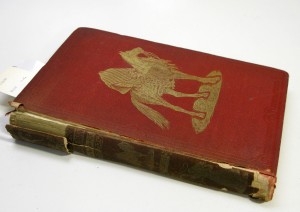
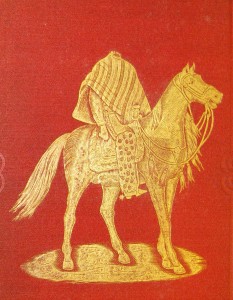
Left: The Headless Horseman, before treatment. Right: A detail of the cover.
Call number C3400, Special Collections. Click images to enlarge.
To bring the book back to a usable condition, first I removed the previous paper spine lining with a softener called methylcellulose.
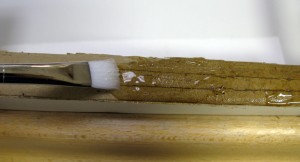
Application of methylcellulose to the spine lining to soften it. Click image to enlarge.
A layer of thick Japanese paper, applied with paste, served as a method for consolidating the spine and reattaching the boards, all at once. The Japanese paper extended onto the boards, under the lifted cloth.
Next I applied a lining that included a tube of paper (called a “hollow”), used to keep the fragile original spine pieces from bending inward when the book is opened. Finally, I dyed some red Moriki Japanese paper to match the cover cloth, and applied that over the tube and under the lifted cloth.
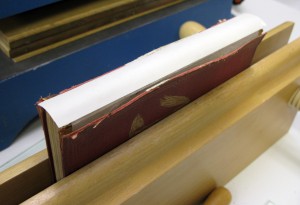
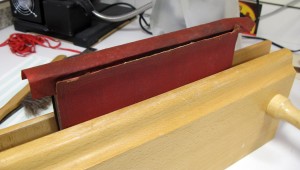
Left: Applying the hollow over the Japanese paper lining. Right: Applying dyed paper over the hollow.
Call number C3400, Special Collections. Click images to enlarge.
The final step was to reattach the loose spine pieces. The spine is still fragile, so I added a polyester dustjacket as a final precaution.

The finished conservation treatment (before the dustjacket).
Call number C3400, Special Collections
The Headless Horseman is ready to ride again!
Whitney Baker
Head, Conservation Services
Tags: Captain Mayne Reid, Conservation Services, conservation treatments, Headless Horseman, Whitney Baker
Posted in Conservation, Special Collections |
No Comments Yet »
February 21st, 2014 Charles Scott, a prominent attorney in Topeka, Kansas, was born in 1921. He served in the U.S. Army during World War II, and later graduated from Washburn Law School. He joined the law firm established by his father, Elisha Scott, Sr., a well-known trial lawyer in the region. During his early years in practice Charles Scott and his father were successful in securing racial integration of elementary schools in South Park, Johnson County, Kansas. With his brother John H. Scott, he represented plaintiffs in several cases that sought to establish the right of access to swimming pools, theaters, and restaurants in Topeka for African Americans.
In 1954 Charles Scott was one of several attorneys who filed and presented the initial case for the plaintiffs in the landmark Supreme Court case Oliver Brown v. the Board of Education of Topeka. He also appeared as counselor for the plaintiffs before the United States Supreme Court, whose ruling ended segregation in public schools.
The Scott Collection includes personal and professional papers that reflect Mr. Scott’s lifelong pursuit of civil rights issues.
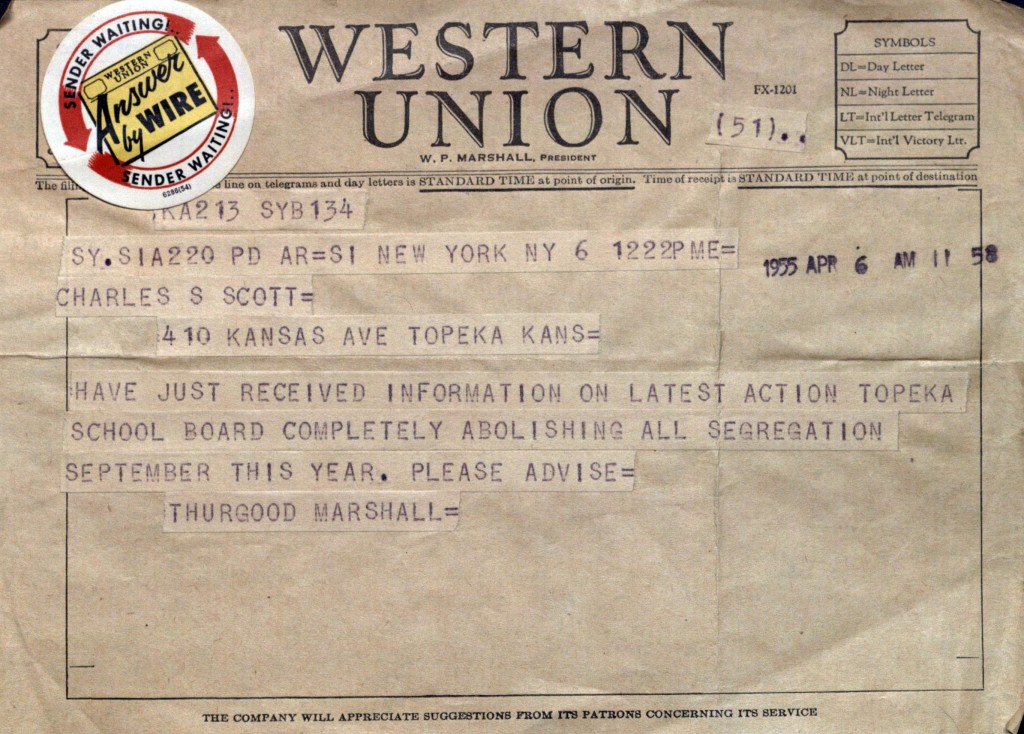
Telegram to Charles Scott from Thurgood Marshall, April 6, 1955. Charles Scott Papers.
Call Number: RH MS 1145, Box 2, Folder 29. Click image to enlarge.
Among Scott’s papers is the above telegram from Thurgood Marshall. Marshall, then serving as Director-Counsel of the NAACP Legal Defense Fund, contacted Scott to receive confirmation of a timetable for desegregation of Topeka schools following the 1954 Supreme Court ruling ending school segregation.
This April, the University of Kansas will host a series of events to mark the 60th anniversary of the Brown v. Board of Education case. These will include a KU Libraries exhibition opening (Lasting Impact: Brown vs the Board of Education) on the evening of April 11th and a daylong seminar on April 12th. Both events will consider the legacy of the case and its implications. For additional information, please see the following news release.
Sheryl Williams
Curator of Collections and Kansas Collection Curator
Tags: African American Experience Collections, Brown v. Board of Education, Charles Scott, Civil Rights, Sheryl Williams, Thurgood Marshall, Twentieth Century History
Posted in Kansas Collection |
No Comments Yet »
February 15th, 2014 The value of a liberal arts education is – and has long been – a topic of substantial discussion. With Valentine’s Day upon us, we wanted to highlight a perhaps little-known benefit of liberal arts courses and majors: they can help you attract or catch a love interest. Such was the “tongue-and-cheek” argument of a pictorial feature that appeared in the April 1970 edition of Kansas Alumni. Seven photographs told a story that unfolded throughout the publication, accompanied by captions extolling the benefits of a liberal arts education that were taken from “none other than” the Catalog of the College of Liberal Arts and Sciences. Prints of six of the images – the first six pictures below – are held within University Archives as part of its collection of Student Activities records and photographs (Record Group 71).

The introduction to “Pictorial: The Liberal Arts” from Kansas Alumni, April 1970.
University Archives. Call Number: RG UA Ser 64/0/2. Click any image to enlarge.

While the lower right corner was cropped out of the published picture, the
original print shows that KU Libraries can also help you catch the
object of your affection! University Archives. Call Number: RG 71/0/1969-1970
Prints: Student Activities (Photos). This citation applies to all images in this
post unless otherwise noted.





The caption for the final image in the story – as it appeared in
Kansas Alumni – doesn’t seem to bode well for the guy behind the books!
University Archives. Call Number: RG UA Ser 64/0/2.
Happy Valentine’s Day!
Caitlin Donnelly
Head of Public Services
Student Activities Photographs RG 71/0 1969/1970 Prints
Tags: Caitlin Donnelly, College of Liberal Arts and Sciences, Kansas Alumni, photographs, Student activities, University of Kansas, Valentine's Day
Posted in University Archives |
No Comments Yet »
February 7th, 2014 It’s been an exciting week or two in Lawrence for scholars and fans of William S. Burroughs. Wednesday, February 5 was the centenary of the writer’s birth, and around town events and exhibitions have been exploring his writing, art, and deep ties to Lawrence. Burroughs made Lawrence his home during the last fifteen years of his life, and now, thanks to a gift from James Grauerholz, executor of the Burroughs estate and a KU alumnus, the influential author’s last journals will join the collections of KU Libraries.
Burroughs helped revolutionize the post-WWII literary landscape with novels like Naked Lunch and Nova Express, the latter a part of his cut-up trilogy. To celebrate the gift, five of the ten journals will be on display in the Kenneth Spencer Research Library’s lobby through February. These notebooks, which span from November 1996 to Burroughs’ death in August of 1997, were the basis for Last Words: The Final Journals of William S. Burroughs, a volume edited by Grauerholz and published in 2000. In their pages we see literature, politics, art, and philosophy collide with everyday life. A reference to speaking with an ailing friend, poet Allen Ginsberg (“His voice over the phone from Beth Israel Hospital in NYC sounded very weak”), appears alongside a reminder to buy disposable razors. The final entry (see below) offers a meditation on conflict and love. To the left Burroughs has written: “Love? What is it? / Most natural pain / killer what there is. / L O V E.”

William S. Burroughs’ final journal. Image courtesy of Chuck France / KU Office of Public Affairs. Click here for a larger version.
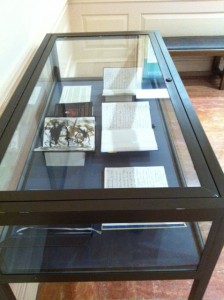

On display through February in Spencer Research Library’s lobby: five of the ten journals donated by the Burroughs estate.
In addition to the journals, the gift also includes typescripts and draft materials for the edition Grauerholz produced. Once cataloged, these “last words” of William S. Burroughs will be available for researchers and the public to consult at the Kenneth Spencer Research Library.
Elspeth Healey,
Special Collections Librarian
Tags: Allen Ginsberg, centenary, donation, Elspeth Healey, gifts, James Grauerholz, Kansas, KU Libraries, Last Words: The Final Journals of William S. Burroughs, Lawrence, twentieth century literature, University of Kansas, William S. Burroughs
Posted in Exhibitions, Special Collections |
No Comments Yet »

















